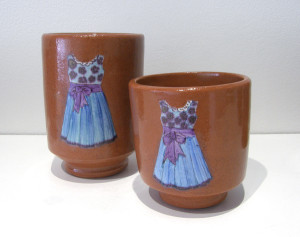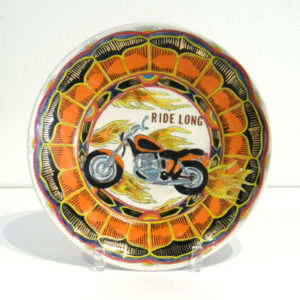
Mariko Paterson. Ride Long. 2015. Clay, glaze, lusters, decals; Thrown, fired multiple times from △ six to △ 018. $600.
MARIKO PATERSON
There are big dishes and little dishes, but the best dishes are narrative dishes! Oh dishes… so many kinds, so many functions, and so little time for me to tackle the virtual slew of possibilities for an artist. While functional ceramics are always of interest to me, I have to admit that where dish-making is concerned, I like to put them through the Lady Gaga creative spin cycle for maximum effect. So bring on the color, bring on the detail, bring out the china paint and, of course, the bling factor; this lady’s got a show to put on!
While an embarrassing pile of Home Sense plates rotate in and out of my cupboards with all clattery and unflattering, the plates and platters I tackle in the studio are more like wall badges of honour. Sometimes slab built with press molds; as late, I have been dabbling in the world of throwing. Each fresh plate presents itself as a canvas that I wait about five whole minutes to delve into with fervor and utter abandon.
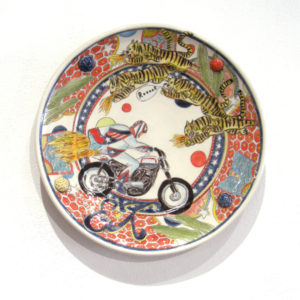
Mariko Paterson. Crouching Knievel, Pouncing Kittens. 2015. Clay, glaze, lusters, decals; Thrown, fired multiple times from △ six to △ 018. $600.
I always dream of making lovely, lilting plates and platters with expanses of white breathing spaces, charming motifs fluttering about to culminate in an air of innuendos reminiscent of a Calvin Klein perfume add. What inevitably transpires is a right collision of Pawn Stars, Hoarders and Dancing with the Stars… In other words, many of my mayhem induced cacophonic platters serves as dance floor in some kind of Saul Steinberg/Studio 54-esque cocktail party moment. Everyone is invited and all tastes are welcome.
The cast of characters starring in this show’s series stream from circus acts of China and America. From Asia we have contorted figures, stacked figures and hula hooping booties to boot. As for my interest in exploiting North America’s popular culture, I have largely honed in on the circus spectacles of Evel Knievel as our wild, wild, western equivalent. The circular platter shape itself serves as a circus ring in which such displays of madness and mayhem often occurs. We, who gaze from ringside, are held captive until the moment of awe has been achieved and then processed and then we move on to the next death-defying feat. I guess the plates could be thought of as TV stills for the wall.
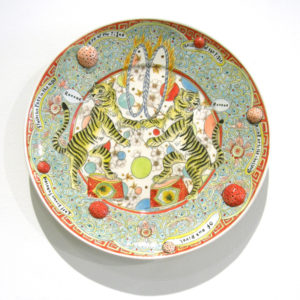
Mariko Paterson. Eye of the Tiger. 2015. Clay, glaze, lusters, decals; Thrown, fired multiple times from △ six to △ 018. $900.
Tying all the platters together is, in fact, an underlying homage to the historical Chinese ceramics. While other series I have ensued have shamelessly unearthed and undermined such Chinese greats as the Q’ing and T’ang Dynasties. The plates completed for The Narrative Dish go for the Kangxi jugular. In particular they borrow from the “Famille” lines produced between 1662 and 1722. Noted for their heavy black lines sectioning off panels for flowers and fauna to happen amidst distinct sections of blue, yellow green and rose, I saw this paneling as somehow akin to graphic novels. But instead of sublime scenes of butterflies and peonies and the like, I clustered everything from motorcycles to acrobatic cycling teams and flames, yeah, lots of flames, into the mix!
Yes, the work might be perceived as a little jarring, but just like Lady Gaga, I have tried to make room for all the extremities to come together. To quote Gaga,“ I am obsessively opposed to the typical.” And for this shared reason I hope that such hybridization of the past and present will make for one fabulously freaky future.
CATHY TEREPOCKI
Some of my very fondest childhood memories are of neighbourhood quilting bees in the Mennonite community where I grew up. My mom, my aunts and my grandma talking amongst themselves in Pennsylvania Dutch (a dialect of German) as they kept their hands busy stitching along the squares and patterns on the quilt frame. My family, on both sides, migrated to Waterloo County in Southern Ontario from Pennsylvania in the mid 1800s. Like many others from Switzerland and Germany, they moved to North America to flee religious persecution. There are many different strains of Mennonites, most indistinguishable from the rest of society, but my ancestors were “plain” Mennonites. They drove black cars and some drove horse and buggies. The women never cut their hair, they only wore dresses, and always wore head-coverings.

Cathy Terepocki. Kitchen Quilt, 2015, Black clay, porcelain slip, coloured underglaze and coloured slip; screen-printed using slip-transfer method (plaster, hand-painted), Not For Sale.
As many other cultures celebrate long traditions of decorative arts, simplicity and “plainness” or lack of ornamentation was central to their Mennonite beliefs. Nearly everything they had was made by hand but utility was first and foremost. Quilts seem to be the one exception to this along with another form of Pennsylvania Dutch Folk Art known as Hex Symbols. In Pennsylvania these designs can be seen painted on barns. These hex signs aren’t part of the Waterloo County Mennonite tradition but the designs are familiar, as they were often found on household objects including recipe books, welcome signs, cookie tins and most famously, Dutch Blitz cards. The patterns and symbols all have specific meanings and were meant to add a blessing and good fortune to a home. Common themes were good health, fertility, and love. Many were also related to abundance in harvest to suit their agrarian lifestyle. Many of the designs in hex symbols can also be found in quilts, like the rosette and six pointed star, although the Mennonites didn’t adhere to the superstitions behind the symbols.
My parents left the Mennonite church shortly after they were married, however, we grew up on a farm sharing the land with my Mennonite grandparents, aunt and uncle, and other family members. The main form of transportation on the road where we lived was horse and buggies.
Quilts are one of the only heirlooms that have been passed on through my family. They have a strong narrative quality, not only for the stories attached to the fabrics used (often from wedding dresses, children’s clothing, etc.), but also for the time, labour, physical and emotional energy that is embedded in these objects. I will probably never make a real hand-quilted quilt but these plates are a reference to my own family history and narrative. They are made using screen-printing and slip-transfer method. The black clay is a subtle reference to the rule in some old order Mennonite groups of having to use black thread over white for its “plainness.”
CAROLE EPP
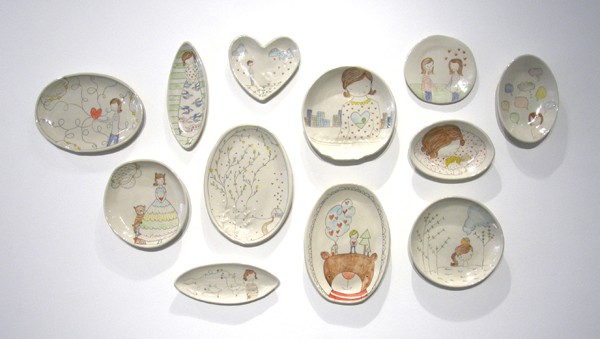
Carole Epp. 2015. Clay, glazes; △ six, handbuilt, underglazes and clear glaze, fired in electric kiln.
Shifts in the aesthetics of my functional work are visibly linked to the birth of my two children and the new emphasis on two-dimensional art in my life through storybooks. Morals and virtues, relationships between animals and their human companions, daily life and rituals are all subject matter of my functional tableware. On the surface of the clay I attempt to capture the whimsy and wonder of childhood, and our desires as adults to reinvest in the innocence of youth. The series presented in The Narrative Dish unveils a new layer of my private life. Each piece is a portrait, a “selfie” in clay of the person I have become, the land wherein I live, the questions I have and the past that still lingers.
ELIZABETH BURRITT
My artistic practice amalgamates ceramics and illustration. This most recent body of work signals two different shifts for me. The first is in the materiality of the work, from porcelain to red earthenware – utilitarian clay, manufactured down the hill from where I live. The second shift is
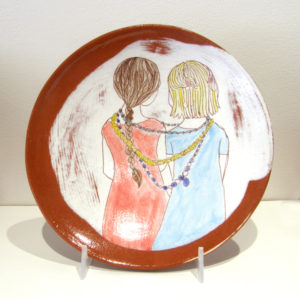
Elizabeth Burritt. Share With Your Sister. 2015. Earthenware, underglaze; Hand-built, hand-painted. NFS.
an artistic one: away from more austere, subtle narratives of place and geography to more personal narratives about relationships and emotion.
This work is about the relationship between sisters, and the special intimacy and complexity that is innate in this dynamic, shaped by birth order, personality, and expectation. I was moved to make this work while watching our own young daughters’ relationship grow and change, which is reflected in my own kinship with my sister.
I am passionate about the importance and authenticity of handmade objects and through my work, I seek to tell just enough of a narrative that the viewer can relate to the work personally and bring their own experiences to the discussion.
JENN DEMKE-LANGE
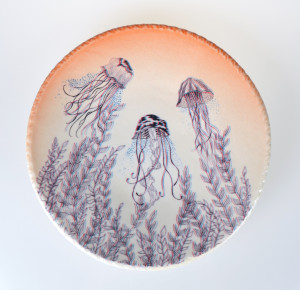
Jenn Demke-Lange. Jellyfish. 2015. Porcelain, glazes; Hand-built, glaze, illustrated anaglyph decals. Sold.
My artistic practice takes interest in creating hand-built functional ceramic objects that are playful and decorative, drawing inspiration from contemporary graphics, patterns, and illustrations. I enjoy discovering all the possibilities that ceramics can offer and create work that through imagery, playful line and clay, capture’s the viewer’s sense of imagination.
These hand-built porcelain plates feature 3D anaglyph decals. They are created using original illustrations that are hand-drawn with pen & ink on paper, digitally manipulated and then printed as food-safe ceramic decals.
An anaglyph image works by creating two views of the same object in contrasting colours (red & cyan) and then slightly offsetting them to create two different perspectives. A 3D effect is then produced when the image is viewed through coloured filters that match the colours in the image.
The Narrative Dish can be viewed at the Affinity Gallery, 813 Broadway Ave, Saskatoon SK, from April 17 – May 23, 2015. Open from 10 am – 5 pm Monday to Saturday; open late Thursday until 8 pm.
Participating artists: Elizabeth Burritt, Aura Carney, Jenn Demke Lange, Carole Epp, Mariko Paterson, Cathy Terepocki. View photos of all the pieces in the exhibition on our website here. Read Carole Epp’s Curatorial Statement here.

